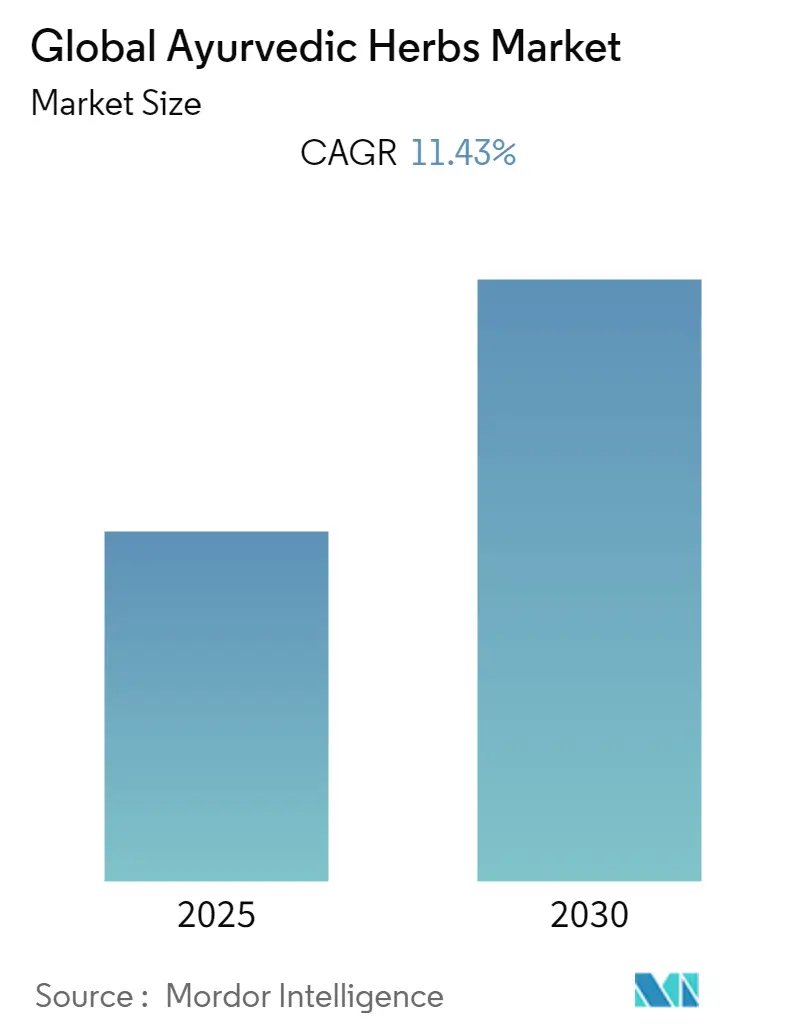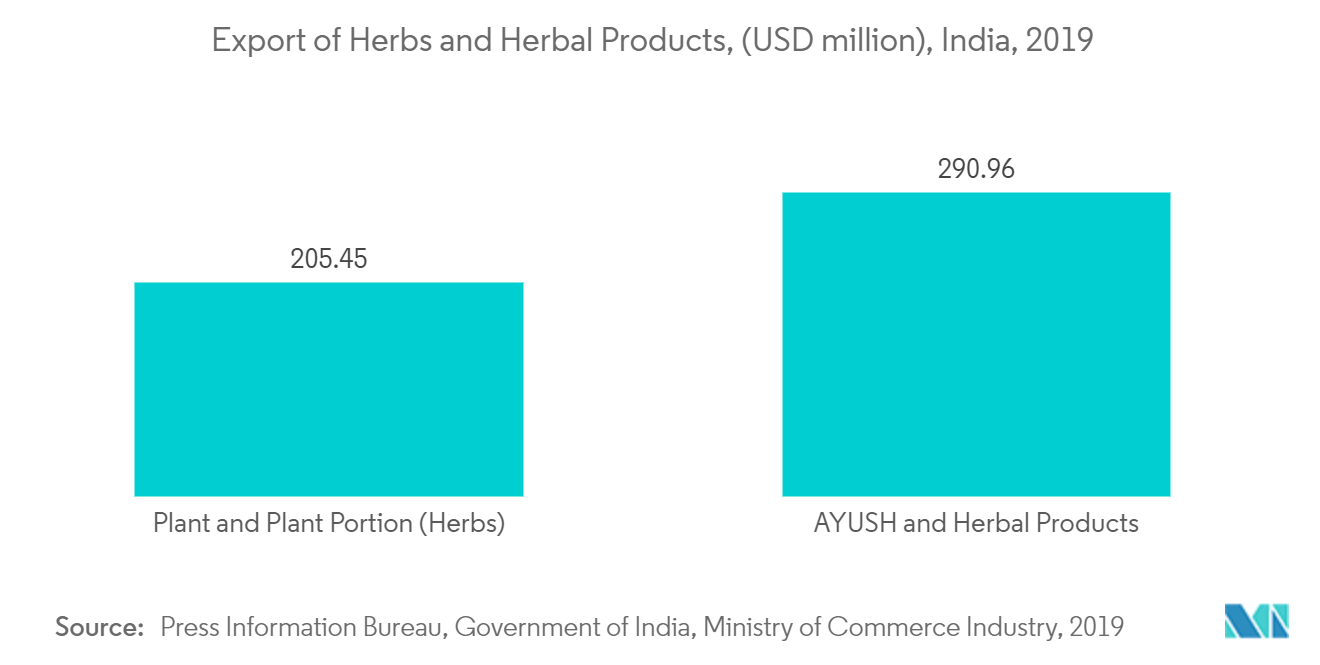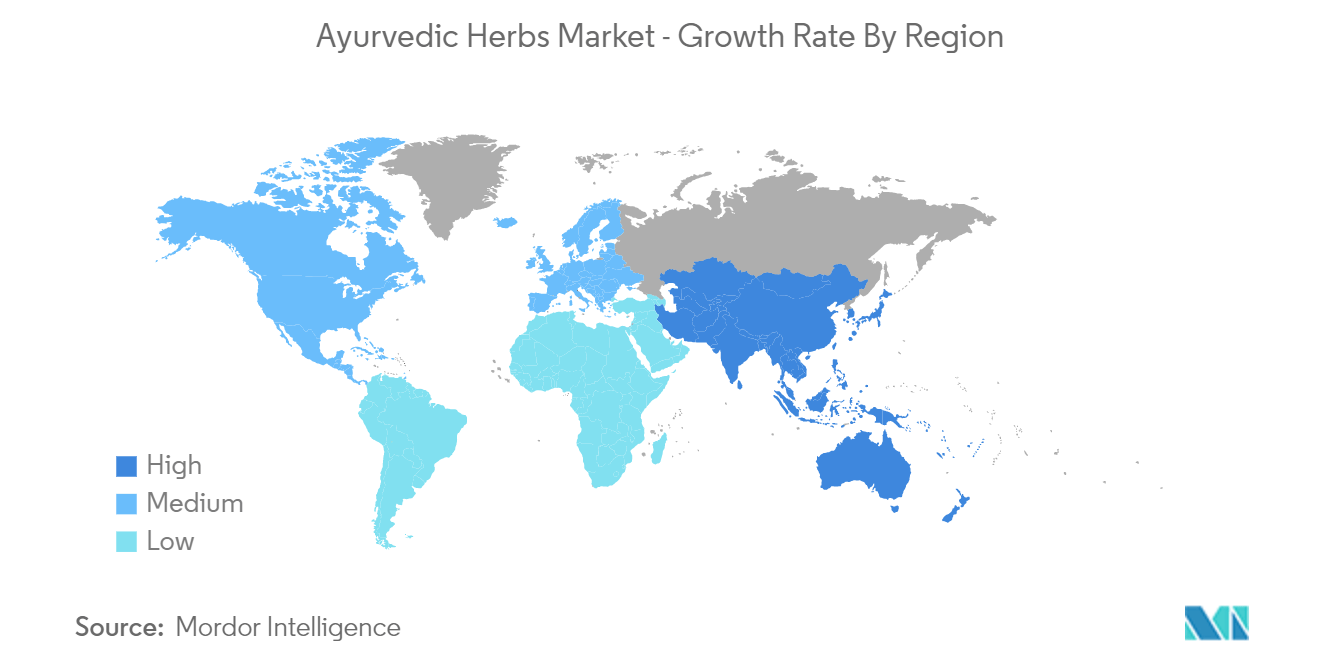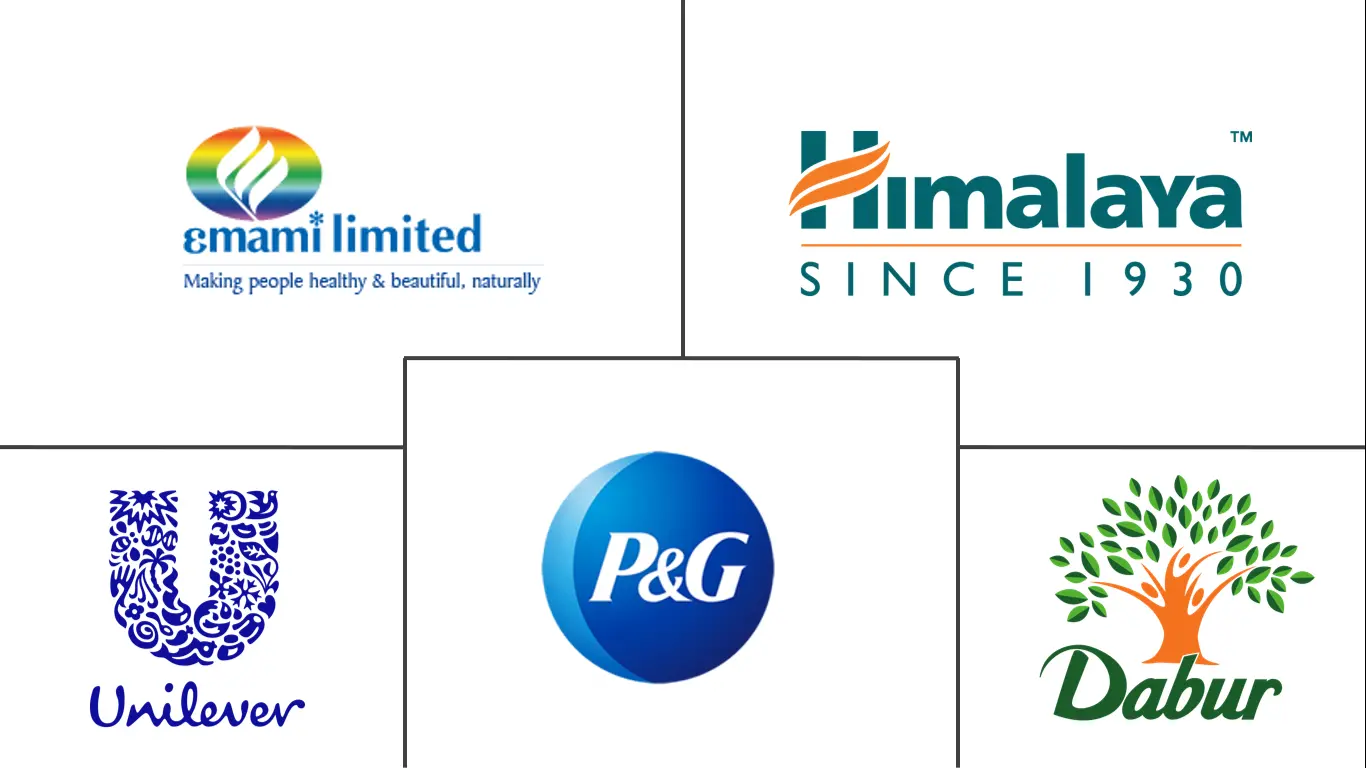Global Ayurvedic Herbs Market Size and Share

Global Ayurvedic Herbs Market Analysis by Mordor Intelligence
The Global Ayurvedic Herbs Market is expected to register a CAGR of 11.43% during the forecast period.
Since the beginning of 2020, the Covid-19 pandemic have changed the healthcare system as well as affected the lifestyle of population worldwide. People were stuck indoors for months. During the isolation target population opt for home remedies and natural food supplement. This led people to follow a 5000-year-old history of Ayurveda. To boost immunity and find ways to live a healthy and safe lifestyle people opted for Ayurvedic treatments and remedies. This has impacted the studied market growth positively. The steps taken by governments have fueled the use of Ayurvedic herbs as preventive measure against Covid-19 infection driving the growth of the studied market. For instance, in October 2020, Ministry of AYUSH (Ayurveda, Yoga, Naturopathy, Unani, Siddha, and Homoeopathy), Government of India released the 'National Clinical Management Protocol based on Ayurveda and Yoga for the management of Covid-19'. In this protocol under the Ayurveda for management of Covid-19 section they have mentioned several use ways of using herbs to prevent the SARS-CoV2 infection. The above protocol suggested to gargle with warm water added with a pinch of turmeric and salt, or to gargle with water boiled with Triphala (dried fruits of Emblica oficinalis, Terminalia chebula,Terminalia bellerica) or Yashtimadhu (Glycyrrhiza glabra). The Nasal instillation of medicated oil (Anu taila or Shadbindu Taila) or plain oil (Sesame or Coconut) or nasal application of cow's ghee (Goghrita) once or twice in a day was suggested to prevent the Covid-19 infection.
Additionally, an article published in October 2020 titled 'A review on exploring the siddha and ayurvedic medicines for covid-19 infection' mentioned that Covid19 has occurred in different types like mild respiratory illness (nose, throat, and lungs), severe acute respiratory syndrome (SARS), and Middle East respiratory syndrome (MERS) and several studies have been done on curative effects of Ayurvedic and other traditional medicines on these various diseases. This above-mentioned article concluded that, Siddha and Ayurvedic medicines have mitigated COVID-19 infections in many cases. Hence, owing to the above-mentioned factors and research, the demand for ayurvedic herbs have increased, driving the growth of the studied market during the Covid-19 pandemic.
Furthermore, factors such as rising burden of chronic diseases globally, and awareness on the side-effects of other medicines is further driving the consumer preference for ayurvedic products, benefiting the studied market. Increasing popularity of natural and organic medicines and their benefits among the consumers also act as a driving factor for the growth of the studied market.
There is an increasing popularity and surging demand of ayurvedic products for several other applications including skin care, hair care, oral care among consumers. Along with government initiatives, this surging demand is driving an increasing number of market players to innovate and develop new products. Hence, boost the growth of the studied market. For instance, in May 2021, Ministry of AYUSH (Ayurveda, Yoga, Naturopathy, Unani, Siddha, and Homoeopathy), India has launched a massive nationwide campaign to distribute its polyherbal ayurvedic drugs AYUSH 64 and Sidha drug Kabasura Kudineer for COVID-19 patients that have not been hospitalized. The efficacy of these two drugs has been proven through strong multi-center clinical trials says the Ministry of AYUSH (Ayurveda, Yoga, Naturopathy, Unani, Siddha, and Homoeopathy).
In addition, Dabur India Ltd. entered the Health Food Drink category with the launch of 'Dabur Vita' in December 2021. Dabur Vita is made with a unique blend of more than 30 herbs such as Ashwagandha, Giloy and Brahmi, which are scientifically proven to provide better immunity as well as to promote physical and mental growth among kids.
Furthermore, an article published in July 2021 titled 'Ayurveda recognized as a system of medicine in 16 countries', by Organiser.org shows that, Ayurveda is recognized as a System of Medicine in Nepal, Sri Lanka, Pakistan, Bangladesh, United Arab Emirates (UAE), Oman, Saudi Arabia, Bahrain, Malaysia, Mauritius, Hungary, Serbia, Tanzania, Switzerland, Cuba, and Brazil. While Romania, Hungary, Latvia, Serbia, and Slovenia are five countries of the European Union (EU), where Ayurvedic practices is regulated. Similarly, several other countries have also incorporated Ayurvedic herbs as systems. According to the similar source, AYUSH (Ayurveda, Yoga, Naturopathy, Unani, Siddha, and Homoeopathy) products are exported to more than 100 foreign countries either as Medicine or as Food supplements.
Therefore, owing to the aforesaid factors the global ayurvedic herbs market is gaining demand globally and is expected to grow over the forecast period.
Global Ayurvedic Herbs Market Trends and Insights
Skin Care and Cosmetics by Personal Product Type is Expected to Grow Over the Forecast Period
Skincare and cosmetics by personal product type is anticipated to show growth over the forecast period.
Ayurveda is a system of medicine that uses natural healing practices to cure clinical conditions such as skin diseases, sinusitis, cough, depression, and insomnia among other conditions. Ayurveda therapies use herbs, which have been integrated into general wellness and in some cases in medical use globally.
Consumers are more conscious about their health and appearance. Hence, investing more in natural and organic products. The chemical products used in some branded cosmetics cause skin problems and gradually damage the skin. As products made from ayurvedic systems use herbs as the main source, the products are safe and cruelty-free to use. These benefits of the ayurvedic products are proved to create more demand for natural and organic skincare and cosmetics products, driving the growth of the segment.
The market players in the market are actively involved in new product launches in the skincare and cosmetic segment. This increasing product launches in the segment is one of the major driving factors affecting the Skincare and cosmetics segment growth. For instance, in March 2021, Lotus Herbals launched a new premium clean beauty brand Lotus Botanicals as a premium brand and targets the growing demand for natural and organic beauty products. This latest brand is vegan and cruelty-free which is based on ingredients such as ginger root and red onion.
In addition, in line with the Union government's (India) push for the application of Ayurveda in food and beauty products, AIMIL Pharma in association with The Fragrance and Flavour Development Centre in Kannauj, India launched the Ayurveda-based beauty product 'Ayouthveda' which is prepared by adding time-tested herbs that are also used in medicines.
Therefore, owing to the aforementioned factors the skincare and cosmetics segment is booing and is expected to drive the growth of the studied market over the next few years.

Asia Pacific is Expected to Dominate the Market in the Forecast Period
The Asia Pacific is expected to dominate the market over the forecast period and beyond owing to the increasing demand for ayurvedic products. Increasing per capita expenditure on natural and organic products, and consumer awareness about the benefits of ayurvedic products are driving the growth of the studied market.
With the shift in demand of customers toward natural products, the demand for Chinese traditional medicine is growing. Along with there has been a surge in demand for Ayurvedic herbs and herbal medicines and products. The ancient medical system in India was known as Ayurveda. This is equal to conventional Western medicine, traditional Chinese medicine, naturopathic medicine, and homeopathic medicine. But the demand for Ayurveda in India as well as in other countries of the region is driving the growth of the studied market in the region.
In August 2020, Dabur expanded its baby care product portfolio and launched 8 new Ayurveda-based products available exclusively on the e-commerce platform Amazon. In addition, in September 2020 Chemo Recovery Kits containing Ayurvedic formulations for cancer patients were launched which was developed by the Integrated Cancer Treatment and Research Centre of the Bharatiya Sanskriti Darshan Trust. Therefore, the increasing number of product launches in the region is expected to boost the studied market growth.
The government initiatives in India to promote Ayurvedic products and medicines are highly effective and drive the growth of the studied market. For instance, in March 2020, India's Ministry of AYUSH (Ayurveda, Yoga, Naturopathy, Unani, Siddha, and Homoeopathy) and the World Health Organisation (WHO) signed a deal worth USD 3.5 million for advancing traditional medicine systems, including Ayurveda. In addition, in March 2022, again WHO and the Government of India signed an agreement to establish the WHO Global Centre for Traditional Medicine in India. The government of India will invest USD 250 million in the development of the Center. Furthermore, in January 2022, the Consulate General of India, Guangzhou organized an event to promote Indian Herbal/Ayurveda/Beauty Products in China. More than 70 Indian exporters have taken part in the event.
Thus, owing to consumer awareness, frequent product launches across various applications and inclined government initiatives in the countries, the Asia Pacific region is expected to dominate the market over the forecast period.

Competitive Landscape
In the current scenario, the number of product launches, collaborations, and other strategies by the market players is increasing and it's fueling the global ayurvedic herbs market. The market is competitive in nature in local markets and globally the market is fairly consolidated in nature due to the lack of presence of major players in the global market. Dabur India Ltd., Colgate-Palmolive Company, Kairali Ayurvedic Group, Emami Limited, Patanjali Ayurved, Unilever, and Procter & Gamble (P&G) are some of the major players among others.
Global Ayurvedic Herbs Industry Leaders
Procter & Gamble (P&G)
Unilever
Emami Limited
Himalaya Wellness Company
Dabur India Limited
- *Disclaimer: Major Players sorted in no particular order

Recent Industry Developments
- In February 2022, Zeon Lifesciences company's research team have developed science-based botanical products with different ayurvedic formulations for the prevention and management of cancer with a multidirectional approach. The company announced its plans to launch its first anti-cancer and pro-immunity product in April 2022.
- In May 2020, Dabur India Limited launched 'Dabur Kovi Rakshak Kit', a combination of time-trusted Ayurvedic Medicines which help in faster recovery from ongoing respiratory infections. Dabur KoviRakshak Kit has been developed and launched based on Indian Council of Medical Research (ICMR) guidelines and after a thorough study of infected patients.
Global Ayurvedic Herbs Market Report Scope
As per the scope of the report, Ayurveda is an ancient Indian healing system that is focused on balancing the mind and spirit, cleansing the body, and defending against disease. Rather than responding to disease, ayurvedic medicine or herbs aims to prevent illness. The practitioners use ayurvedic herbs as a holistic approach to health including Nutrition, Yoga, Aromatherapy, Meditation, Therapeutic oils, Skincare products, and others.
The ayurvedic herbs market is segmented by Product Type (Healthcare Products and Personal Products), Application (Skin Diseases, Respiratory Disorders, Autoimmune Diseases, Cancer Treatment, Cardiovascular Diseases, and Other Applications), Distribution Channel (Retail Pharmacy, E-Pharmacy, and Other Distribution Channels) and Geography (North America, Europe, Asia-Pacific, Middle East & Africa, and South America). The report offers the value (in USD million) for the above segments.
| Healthcare Products | Ayurvedic Nutraceuticals |
| Ayurvedic Medicines | |
| Dietary Supplements | |
| Personal Products | Oral Care |
| Hair Care and Fragrances | |
| Skin care and Cosmetics |
| Skin Diseases |
| Respiratory Disorders |
| Autoimmune Diseases |
| Cancer Treatment |
| Cardiovascular Diseases |
| Other Applications |
| Retail Pharmacy |
| E-Pharmacy |
| Other Distribution Channel |
| North America |
| Europe |
| Asia-Pacific |
| Middle East and Africa |
| South America |
| By Product Type | Healthcare Products | Ayurvedic Nutraceuticals |
| Ayurvedic Medicines | ||
| Dietary Supplements | ||
| Personal Products | Oral Care | |
| Hair Care and Fragrances | ||
| Skin care and Cosmetics | ||
| By Application | Skin Diseases | |
| Respiratory Disorders | ||
| Autoimmune Diseases | ||
| Cancer Treatment | ||
| Cardiovascular Diseases | ||
| Other Applications | ||
| By Distribution Channel | Retail Pharmacy | |
| E-Pharmacy | ||
| Other Distribution Channel | ||
| Geography | North America | |
| Europe | ||
| Asia-Pacific | ||
| Middle East and Africa | ||
| South America | ||
Key Questions Answered in the Report
What is the current Global Ayurvedic Herbs Market size?
The Global Ayurvedic Herbs Market is projected to register a CAGR of 11.43% during the forecast period (2025-2030)
Who are the key players in Global Ayurvedic Herbs Market?
Procter & Gamble (P&G), Unilever, Emami Limited, Himalaya Wellness Company and Dabur India Limited are the major companies operating in the Global Ayurvedic Herbs Market.
Which is the fastest growing region in Global Ayurvedic Herbs Market?
Europe is estimated to grow at the highest CAGR over the forecast period (2025-2030).
Which region has the biggest share in Global Ayurvedic Herbs Market?
In 2025, the Asia-Pacific accounts for the largest market share in Global Ayurvedic Herbs Market.
What years does this Global Ayurvedic Herbs Market cover?
The report covers the Global Ayurvedic Herbs Market historical market size for years: 2019, 2020, 2021, 2022, 2023 and 2024. The report also forecasts the Global Ayurvedic Herbs Market size for years: 2025, 2026, 2027, 2028, 2029 and 2030.
Page last updated on:
Global Ayurvedic Herbs Market Report
Statistics for the 2025 Global Ayurvedic Herbs market share, size and revenue growth rate, created by Mordor Intelligence™ Industry Reports. Global Ayurvedic Herbs analysis includes a market forecast outlook for 2025 to 2030 and historical overview. Get a sample of this industry analysis as a free report PDF download.



